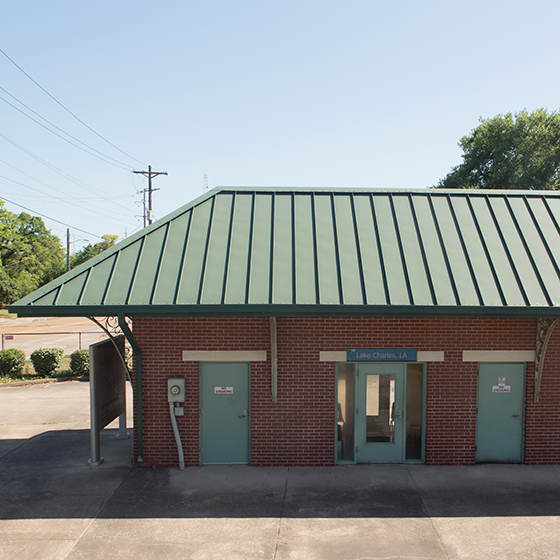Lake Charles, LA (LCH)
Settled in the 1760s by French immigrants, Lake Charles thrived on the lumber industry. The city is known for hosting more than 70 annual festivals, many of which celebrate Acadian culture.

100 Ryan Street
Lake Charles, LA 70601-2152
Annual Station Ridership (FY 2024): 2,940
- Facility Ownership: City of Lake Charles
- Parking Lot Ownership: City of Lake Charles
- Platform Ownership: City of Lake Charles
- Track Ownership: Union Pacific Railroad
Todd Stennis
Regional Contact
governmentaffairsnol@amtrak.com
For information about Amtrak fares and schedules, please visit Amtrak.com or call 1-800-USA-RAIL (1-800-872-7245).
The Lake Charles train station was opened at its current location on December 21, 1999. Set back a short distance from the tracks, it was modeled after a Texas & Orleans Railroad station that was located across the street on South Railroad Avenue, which burned down in the late 1980s. Today’s station is a 1,200 square-foot building constructed of redbrick and a metal-clad roof. The depot includes a terminal, a decorative waiting area, an office used by the caretaker, and restrooms. The new train station was an initiative sponsored by former Lake Charles’ then Mayor Willie Mount, Amtrak and Player’s River Casino.
Lake Charles became connected to the rest of the nation by rail in the late 19th century. The advent of rail travel changed the ambiance of the town, with daily trains running from Vermilionville (Lafayette) to Houston, with more than 800 freight cars passing through Lake Charles in October 1880. On April 2, 1880, the Louisiana Western Railroad transported from Lacassine to Lake Charles the first shipment of country produce ever delivered by rail.
In the nearby town of DeQuincy, the historic Kansas City Southern Depot now serves as the DeQuincy Railroad Museum, a museum that pays tribute to the railroad’s importance to the town’s history. DeQuincy was laid out in 1896 when the main line of the Kansas City, Pittsburgh, and Gulf Railroad reached the area. The Kansas City Southern and the Union Pacific Railroads contributed greatly to the local economy throughout the years. The museum boasts a 1913 steam locomotive, a passenger car, a caboose, and many other railroad artifacts.
The city of Lake Charles was occupied by several Native American tribes until European settlers arrived in the 1760s, the first of which came from Bordeaux, France. Lake Charles was originally named Charles Town in honor of one of the area’s first European settlers, Charles Sallier. On March 7, 1861, Lake Charles was officially incorporated as a town under the name Charleston. Six years later, the town was renamed Lake Charles after many expressed discontent with the name Charleston.
The city’s growth was due mainly to the lumber industry. Timber sales from the area’s bald cypress and longleaf pine generated the city’s revenue. In 1855, Captain Daniel Goos, a German by birth, moved to Lake Charles and set up a lumber mill and a schooner dock, now called Goosport. He promoted trade with both Texas and Mexico. After the Civil War, many Victorian mansions were built in Lake Charles using wood from the city’s pine mills. Today, this historic district is known as the Charpentier district.
Lake Charles is the fifth-largest city in Louisiana, and one of the most important cultural centers in Acadiana (the region in Southwest Louisiana settled by French Canadians). Lake Charles is often referred to as the Festival Capital of Louisiana, celebrating 75 festivals annually. In May, Lake Charles residents recognize “Contraband Days,” one of the largest festivals in Louisiana, reenacting pirate Jean Lafitte’s capture of the city’s port and hurling the mayor into the lake. As is tradition in South Louisiana, Mardi Gras krewes parade through the streets during Carnival Season. Other festivals include the Marshland Festival and the Cajun Music and Food Festival.
Station Building (with waiting room)
Features
- ATM not available
- No elevator
- No payphones
- No Quik-Trak kiosks
- No Restrooms
- Unaccompanied child travel not allowed
- No vending machines
- No WiFi
- Arrive at least 30 minutes prior to departure
Baggage
- Amtrak Express shipping not available
- No checked baggage service
- No checked baggage storage
- Bike boxes not available
- No baggage carts
- Ski bags not available
- No bag storage
- Shipping boxes not available
- No baggage assistance
Parking
- Same-day parking is available; fees may apply
- Overnight parking is available; fees may apply
Accessibility
- No payphones
- Accessible platform
- Accessible restrooms
- No accessible ticket office
- Accessible waiting room
- No accessible water fountain
- Same-day, accessible parking is available; fees may apply
- Overnight, accessible parking is available; fees may apply
- No high platform
- No wheelchair
- No wheelchair lift
Hours


 Amtrak established the Great American Stations Project in 2006 to educate communities on the benefits of redeveloping train stations, offer tools to community leaders to preserve their stations, and provide the appropriate Amtrak resources.
Amtrak established the Great American Stations Project in 2006 to educate communities on the benefits of redeveloping train stations, offer tools to community leaders to preserve their stations, and provide the appropriate Amtrak resources. Amtrak is seizing a once-in-a-lifetime opportunity to transform rail and Retrain Travel. By modernizing, enhancing and expanding trains, stations and infrastructure, Amtrak is meeting the rising demand for train travel. Amtrak offers unforgettable experiences to more than 500 destinations across 46 states and parts of Canada. Learn more at
Amtrak is seizing a once-in-a-lifetime opportunity to transform rail and Retrain Travel. By modernizing, enhancing and expanding trains, stations and infrastructure, Amtrak is meeting the rising demand for train travel. Amtrak offers unforgettable experiences to more than 500 destinations across 46 states and parts of Canada. Learn more at